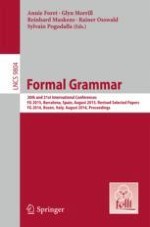This book constitutes the refereed proceedings of the 20th and 21st International Conference on Formal Grammar 2015 and 2016, collocated with the European Summer School in Logic, Language and Information in August 2015/2016. The 19 revised full papers presented together with 2 invited talks were carefully reviewed and selected from a total of 34 submissions.
The focus of papers are as follows:
Formal and computational phonology, morphology, syntax, semantics and pragmaticsModel-theoretic and proof-theoretic methods in linguistics
Logical aspects of linguistic structure
Constraint-based and resource-sensitive approaches to grammar
Learnability of formal grammar
Integration of stochastic and symbolic models of grammar
Foundational, methodological and architectural issues in grammar and linguistics
Mathematical foundations of statistical approaches to linguistic analysis
